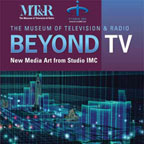June 07, 2006
The Museum of Television & Radio

Beyond TV: New Media Art from Studio IMC
The Museum of Television & Radio Presents Beyond TV: New Media Art from Studio IMC An Interactive Gallery Exhibit in the Spielberg Gallery, 6/2 - 8/31, 2006. Visitors are offered the opportunity to experience technologies used in video games, the Internet, social software, and cell phones.
Comprised of five separate pieces--CINE 2.0, Swarm, freeSTYLE, Zig Zag Muzig Block, and LifeForce--this exhibit of interactive art offers visitors the opportunity to experience technologies used in video games, the Internet, social software, and cell phones—all of which will ultimately have an impact on television as we know it today.
CINE 2.0 (Collaborative Immersive Networked Environment, pronounced "sign") by Artists: James Tunick, Miro Kirov, and Houston Riley with Tony Rizzaro and Braden Weeks Earp: CINE 2.0 is a mixed-media environment inspired by Star Trek: The Next Generation’s Holodeck. Multiple users fly through an urban datascape in an immersive environment by using body gestures. Participants in the environment can also collaborate to compose music and, in addition, people out in the city itself can send photographs from their cell phones to be incorporated into the datascape environment.
CINE takes the computer screen out of the box and reconfigures it as a life-size environment. Control of visuals and sound takes place through full-body gestures rather than just mouse-clicks. As the traditional computer screen and mouse-keyboard interface transforms to fill the room, future entertainment platforms like CINE will enhance collaboration among multiple users, opening up whole new worlds of learning, art, creativity, and play. CINE is powered by a network of servers and computers that includes Studio IMC's BlackBox and IMCvote mobile technology.
Swarm by Daniel Shiffman: Swarm paints a digital portrait of the viewer. Stationary viewers will see their portrait, while moving ones will produce an image more like an abstract painting.
Swarm is an interactive video installation that implements the pattern of flocking birds (using Craig Reynold’s “Boids” model) as a constantly moving brush stroke. Taking inspiration from Jackson Pollack’s “drip and splash” technique of pouring a continuous stream of paint onto a canvas, Swarm smears colors captured from a live video input of the person looking at the screen, producing an organic painterly effect in real time. The person viewing the screen becomes part of the art.
freeSTYLE by Dana Karwas: freeSTYLE is a music video created entirely from cell phones. Video clips and text messages are sent in by cell phone, which are then sequenced at random and mixed with music to create a living, abstract music video. Participants can send a video or text message to 1[at]dk22.com.
Cell phones offer an extension of one's identity. Users can send messages to freeSTYLE and, in return, they will hear and see their messages free-styled back to them with an added beat. Guided by a hip-hop beat of choice, the user can hear and see their mobile presence in the form of a living music video.
Zig Zag Muzig Block (ZZMB) by Inhye Lee : Going beyond the tradition of the children's mix-and-match toy, ZZMB allows the viewer to create new characters from four existing singing characters by rotating or sliding each block. Playing with ZZMB's blocks also creates new musical compositions.
Each top, middle, and bottom block plays a different character's voice, harmony (chord), and rhythm (beat) of music, which are written as parts of complete scores. Users can make variations of the sound by applying different voices, chords, or rhythms from other blocks. When blocks are matched to compose one of the original, matching characters, users can hear the full original score. Slide the blocks to the side to make more musical variations.
LifeForce by James Tunick: LifeForce transforms the cell phone into a digital paint brush and musical instrument. The work comes alive only when the viewer participates, waving a cell phone to "paint" with light and sound. Multiple users can control the pulsing visuals as well as push sounds across the space.
Powered by Studio IMC's BlackBox media player and custom software, the installation invites viewers to collaborate utilizing a flatscreen, stereo sound, and cell phones. The work is a commentary on the need for more participatory art forms in contemporary museums, and strives to validate the mobile device as a tool for creative expression. LifeForce envisions a future in which such artistic tools are common to public spaces like city sidewalks and sides of buildings.
Studio IMC (Interactive Multimedia Culture)—a New York City-based new media agency comprised of an international team of artists and software engineers—envisions the future of group entertainment and collaboration and imagines what's waiting for us beyond the relatively passive, "hands-off" experience of watching TV. Studio IMC fuses old and new media concepts and technologies to create a brave new world of participatory—at times even immersive—media consumption. There are no "Do Not Touch" signs here—instead, you're encouraged to touch everything and actually become part of the artwork yourselves.
Posted by jo at June 7, 2006 08:38 AM
